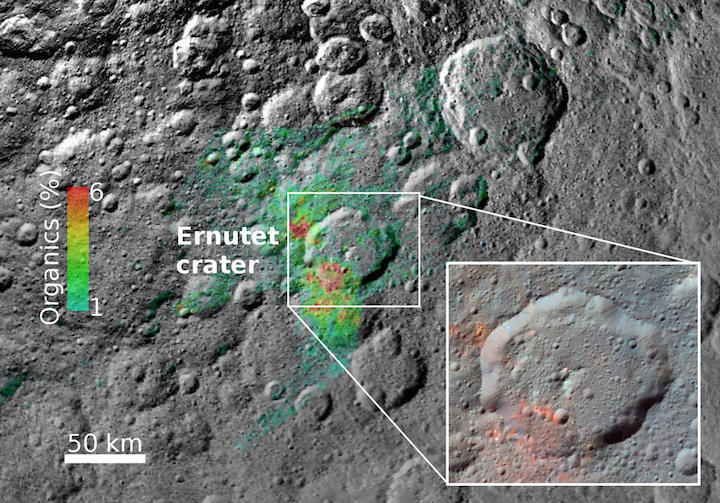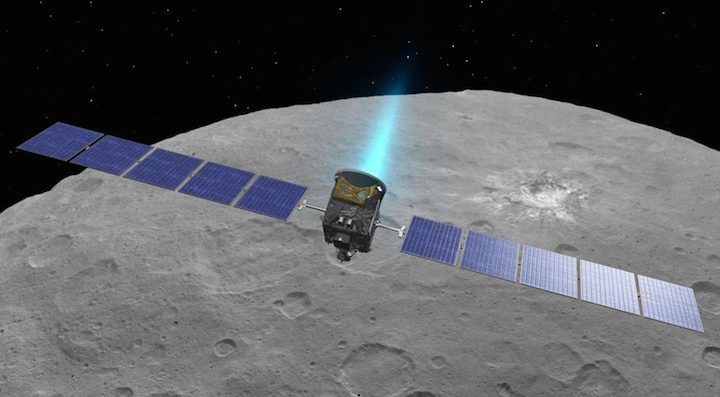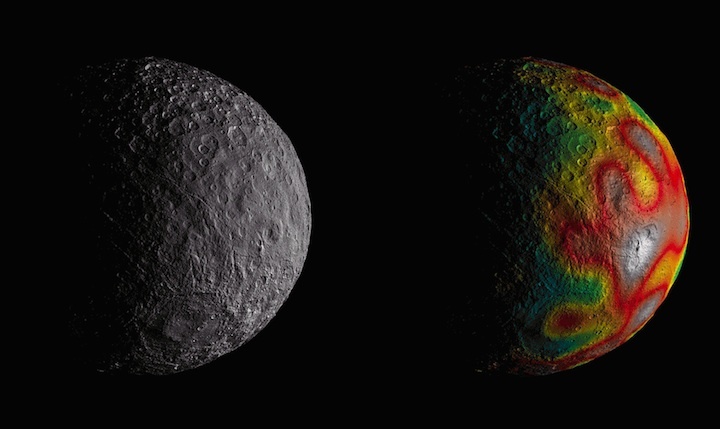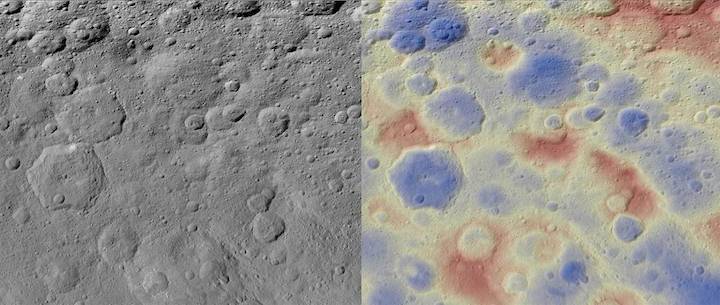CERES' CRUST AS WE SEE IT TODAY, WITH ITS MIXTURE OF ICE, SALTS AND HYDRATED MATERIALS, REPRESENTS MOST OF THE DWARF PLANET'S ANCIENT OCEAN, SCIENTISTS SAY
WASHINGTON D.C. — Minerals containing water are widespread on Ceres, suggesting the dwarf planet may have had a global ocean in the past. What became of that ocean? Could Ceres still have liquid today? Two new studies from NASA’s Dawn mission shed light on these questions.
In one study, the Dawn team found Ceres’ crust is a mixture of ice, salts and hydrated materials that were subjected to past and possibly recent geologic activity, and this crust represents most of that ancient ocean. The second study builds off the first and suggests there is a softer, easily deformable layer beneath Ceres’ rigid surface crust, which could be the signature of residual liquid left over from the ocean, too.
“More and more, we are learning that Ceres is a complex, dynamic world that may have hosted a lot of liquid water in the past, and may still have some underground,” said Julie Castillo-Rogez, Dawn project scientist and co-author of the studies, based at NASA’s Jet Propulsion Laboratory, Pasadena, California.
What’s inside Ceres?
Landing on Ceres to investigate its interior would be technically challenging and would risk contaminating the dwarf planet. Instead, scientists use Dawn’s observations in orbit to measure Ceres’ gravity, to estimate its composition and interior structure.
The first of the two studies, led by Anton Ermakov, a postdoctoral researcher at JPL, used shape and gravity data measurements from the Dawn mission to determine the internal structure and composition of Ceres. The measurements came from observing the spacecraft’s motions with NASA’s Deep Space Network to track small changes in the spacecraft’s orbit. This study is accepted for publication in the Journal of Geophysical Research: Planets, a journal of the American Geophysical Union.
Ermakov and his colleagues’ research supports the possibility that Ceres is geologically active – if not now, then it may have been in the recent past. Three craters – Occator, Kerwan and Yalode – and Ceres’ solitary tall mountain, Ahuna Mons, are all associated with gravity anomalies. This means discrepancies between the scientists’ models of Ceres’ gravity and what Dawn observed in these four locations can be associated with subsurface structures.
“Ceres has an abundance of gravity anomalies associated with outstanding geologic features,” Ermakov said. In the cases of Ahuna Mons and Occator, the anomalies can be used to better understand the origin of these features, which are believed to be different expressions of cryovolcanism.
The study found the crust’s density to be relatively low, closer to that of ice than rocks. However, a study by Dawn guest investigator Michael Bland of the U.S. Geological Survey indicated that ice is too soft to be the dominant component of Ceres’ strong crust. So, how can Ceres’ crust be as light as ice in terms of density, but simultaneously much stronger? To answer this question, another team modeled how Ceres’ surface evolved with time.
A ‘fossil’ ocean at Ceres
The second study, led by Roger Fu at Harvard University in Cambridge, Massachusetts, investigated the strength and composition of Ceres’ crust and deeper interior by studying the dwarf planet’s topography. This study is published in Earth and Planetary Science Letters.
By studying how topography evolves on a planetary body, scientists can understand the composition of its interior. A strong, rock-dominated crust can remain unchanged over the 4.5-billion-year-old age of the solar system, while a weak crust rich in ices and salts would deform over that time.
By modeling how Ceres’ crust flows, Fu and colleagues found it is likely a mixture of ice, salts, rock and an additional component believed to be clathrate hydrate. A clathrate hydrate is a cage of water molecules surrounding a gas molecule. This structure is 100 to 1,000 times stronger than water ice, despite having nearly the same density.
The researchers believe Ceres once had more pronounced surface features, but they have smoothed out over time. This type of flattening of mountains and valleys requires a high-strength crust resting on a more deformable layer, which Fu and colleagues interpret to contain a little bit of liquid.
The team thinks most of Ceres’ ancient ocean is now frozen and bound up in the crust, remaining in the form of ice, clathrate hydrates and salts. It has mostly been that way for more than 4 billion years. But if there is residual liquid underneath, that ocean is not yet entirely frozen. This is consistent with several thermal evolution models of Ceres published prior to Dawn’s arrival there, supporting the idea that Ceres’ deeper interior contains liquid left over from its ancient ocean.
Quelle: AGU
---
Update: 14.12.2017
.
Bright Areas on Ceres Suggest Geologic Activity
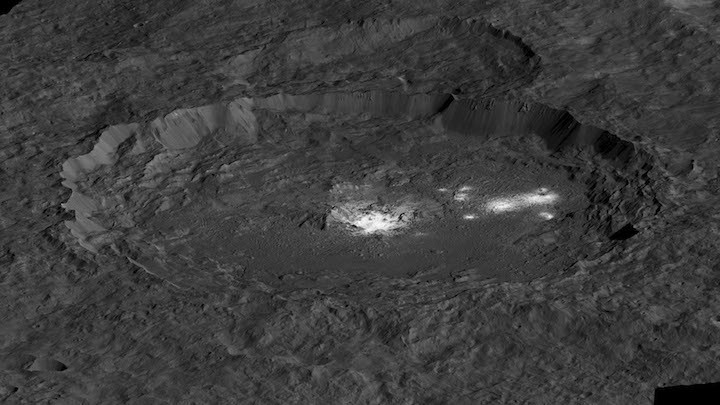
The bright areas of Occator Crater -- Cerealia Facula in the center and Vinalia Faculae to the side -- are examples of bright material found on crater floors on Ceres. This is a simulated perspective view. Image Credit: NASA/JPL-Caltech/UCLA/MPS/DLR/IDA/PSI
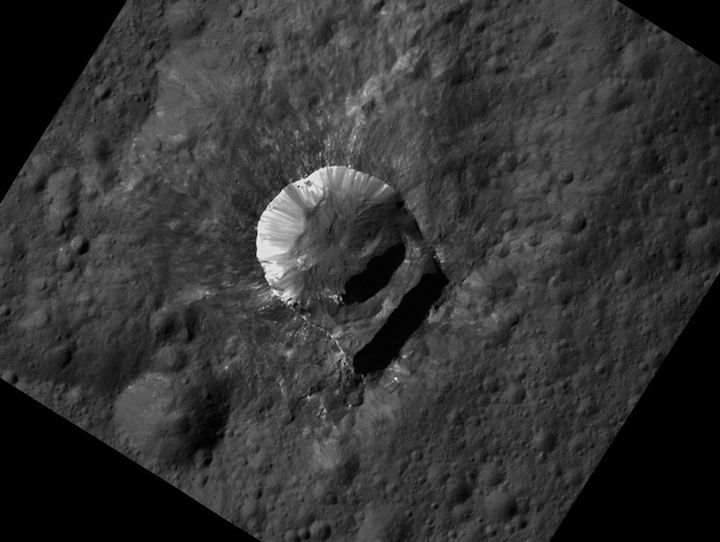
Oxo Crater is an example of bright material found on the rims of a crater on Ceres. Credit: NASA/JPL-Caltech/UCLA/MPS/DLR/IDA/PSI
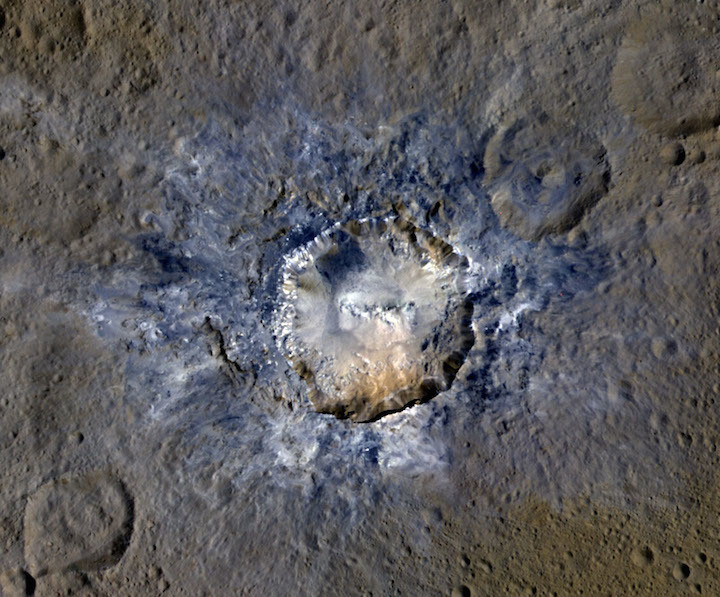
Ceres' Haulani Crater, with a diameter of 21 miles (34 kilometers), shows evidence of landslides from its crater rim. Credit: NASA/JPL-Caltech/UCLA/MPS/DLR/IDA
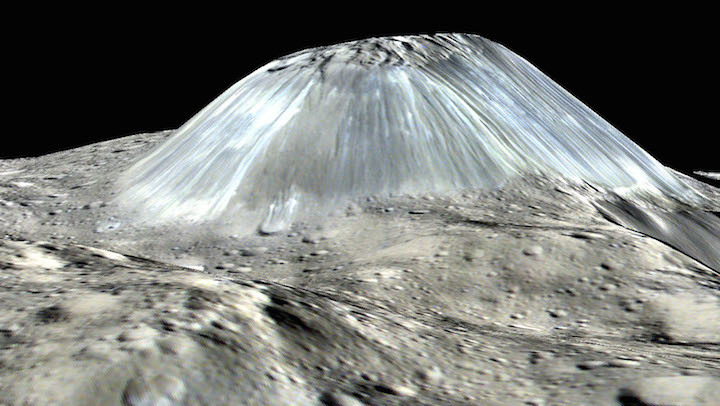
Ahuna Mons, Ceres' unique tall mountain, hosts the only example of bright material on Ceres that is not associated with an impact. This is a simulated perspective view. Image Credit: NASA/JPL-Caltech/UCLA/MPS/DLR/IDA
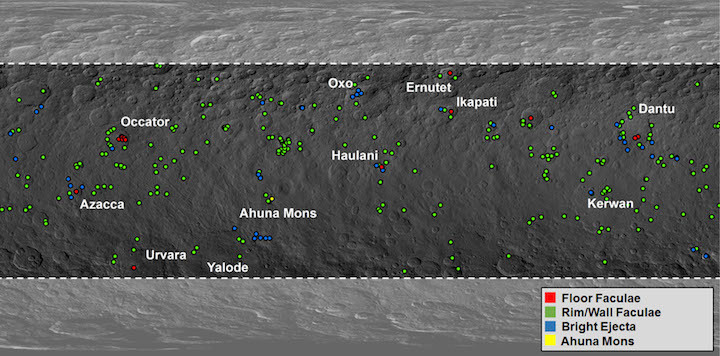
This map from NASA's Dawn mission shows locations of bright material on dwarf planet Ceres. There are more than 300 bright areas, called "faculae," on Ceres. Image Credit: NASA/JPL-Caltech/UCLA/MPS/DLR/IDA/PSI/Caltech
-
If you could fly aboard NASA's Dawn spacecraft, the surface of dwarf planet Ceres would generally look quite dark, but with notable exceptions. These exceptions are the hundreds of bright areas that stand out in images Dawn has returned. Now, scientists have a better sense of how these reflective areas formed and changed over time -- processes indicative of an active, evolving world.
"The mysterious bright spots on Ceres, which have captivated both the Dawn science team and the public, reveal evidence of Ceres' past subsurface ocean, and indicate that, far from being a dead world, Ceres is surprisingly active. Geological processes created these bright areas and may still be changing the face of Ceres today," said Carol Raymond, deputy principal investigator of the Dawn mission, based at NASA's Jet Propulsion Laboratory in Pasadena, California. Raymond and colleagues presented the latest results about the bright areas at the American Geophysical Union meeting in New Orleans on Tuesday, Dec. 12.
Different Kinds of Bright Areas
Since Dawn arrived in orbit at Ceres in March 2015, scientists have located more than 300 bright areas on Ceres. A new study in the journal Icarus, led by Nathan Stein, a doctoral researcher at Caltech in Pasadena, California, divides Ceres' features into four categories.
The first group of bright spots contains the most reflective material on Ceres, which is found on crater floors. The most iconic examples are in Occator Crater, which hosts two prominent bright areas. Cerealia Facula, in the center of the crater, consists of bright material covering a 6-mile-wide (10-kilometer-wide) pit, within which sits a small dome. East of the center is a collection of slightly less reflective and more diffuse features called Vinalia Faculae. All the bright material in Occator Crater is made of salt-rich material, which was likely once mixed in water. Although Cerealia Facula is the brightest area on all of Ceres, it would resemble dirty snow to the human eye.
› DOWNLOAD VIDEO The Bright Stuff: New NASA Dawn Findings at Ceres
More commonly, in the second category, bright material is found on the rims of craters, streaking down toward the floors. Impacting bodies likely exposed bright material that was already in the subsurface or had formed in a previous impact event.
Separately, in the third category, bright material can be found in the material ejected when craters were formed.
The mountain Ahuna Mons gets its own fourth category -- the one instance on Ceres where bright material is unaffiliated with any impact crater. This likely cryovolcano, a volcano formed bythe gradual accumulation of thick, slowly flowing icy materials, has prominent bright streaks on its flanks.
Over hundreds of millions of years, bright material has mixed with the dark material that forms the bulk of Ceres' surface, as well as debris ejected during impacts. That means billions of years ago, when Ceres experienced more impacts, the dwarf planet's surface likely would have been peppered with thousands of bright areas.
"Previous research has shown that the bright material is made of salts, and we think subsurface fluid activity transported it to the surface to form some of the bright spots," Stein said.
The Case of Occator
Why do the different bright areas of Occator seem so distinct from one another? Lynnae Quick, a planetary geologist at the Smithsonian Institution in Washington, has been delving into this question.
The leading explanation for what happened at Occator is that it could have had, at least in the recent past, a reservoir of salty water beneath it. Vinalia Faculae, the diffuse bright regions to the northeast of the crater's central dome, could have formed from a fluid driven to the surface by a small amount of gas, similar to champagne surging out of its bottle when the cork is removed.
In the case of the Vinalia Faculae, the dissolved gas could have been a volatile substance such as water vapor, carbon dioxide, methane or ammonia. Volatile-rich salty water could have been brought close to Ceres' surface through fractures that connected to the briny reservoir beneath Occator. The lower pressure at Ceres' surface would have caused the fluid to boil off as a vapor. Where fractures reached the surface, this vapor could escape energetically, carrying with it ice and salt particles and depositing them on the surface.
Cerealia Facula must have formed in a somewhat different process, given that it is more elevated and brighter than Vinalia Faculae. The material at Cerealia may have been more like an icy lava, seeping up through the fractures and swelling into a dome. Intermittent phases of boiling, similar to what happened when Vinalia Faculae formed, may have occurred during this process, littering the surface with ice and salt particles that formed the Cerealia bright spot.
Quick's analyses do not depend on the initial impact that formed Occator. However, the current thinking among Dawn scientists is that when a large body slammed into Ceres, excavating the 57-mile-wide (92-kilometer-wide) crater, the impact may have also created fractures through which liquid later emerged.
"We also see fractures on other solar system bodies, such as Jupiter's icy moon Europa," Quick said. "The fractures on Europa are more widespread than the fractures we see at Occator. However, processes related to liquid reservoirs that might exist beneath Europa's cracks today could be used as a comparison for what may have happened at Occator in the past."
As Dawn continues the final phase of its mission, in which it will descend to lower altitudes than ever before, scientists will continue learning about the origins of the bright material on Ceres and what gave rise to the enigmatic features in Occator.
The Dawn mission is managed by JPL for NASA's Science Mission Directorate in Washington. Dawn is a project of the directorate's Discovery Program, managed by NASA's Marshall Space Flight Center in Huntsville, Alabama. UCLA is responsible for overall Dawn mission science. Orbital ATK Inc., in Dulles, Virginia, designed and built the spacecraft. The German Aerospace Center, Max Planck Institute for Solar System Research, Italian Space Agency and Italian National Astrophysical Institute are international partners on the mission team.
Quelle: NASA
---
Update: 27.12.2017
.

